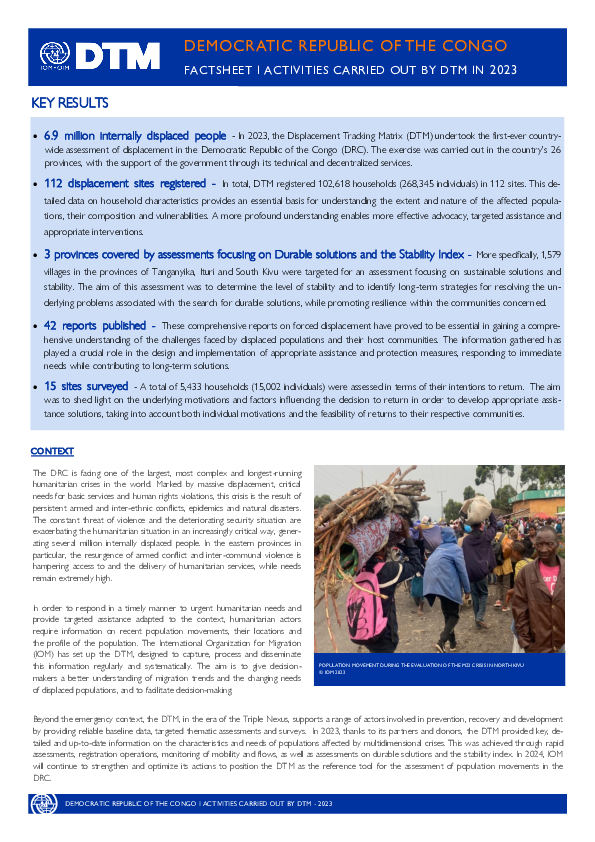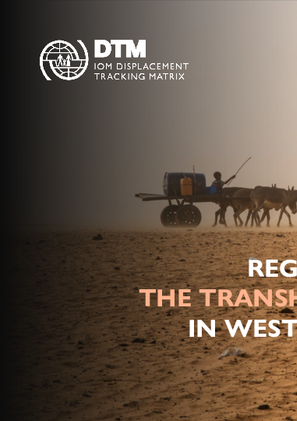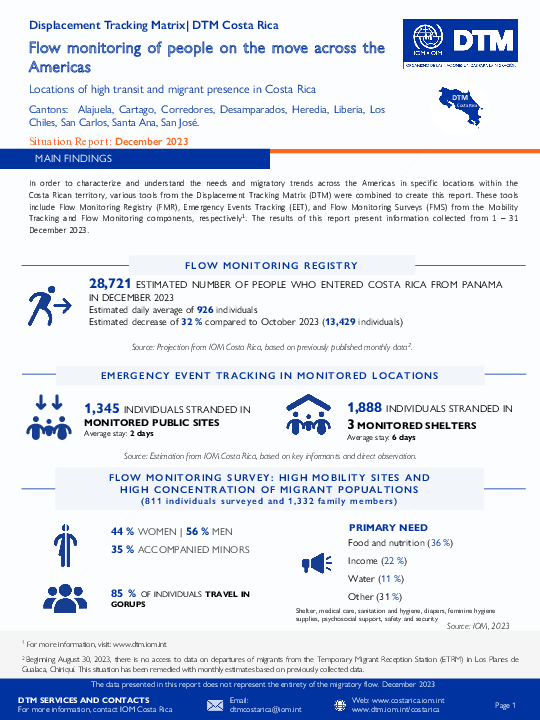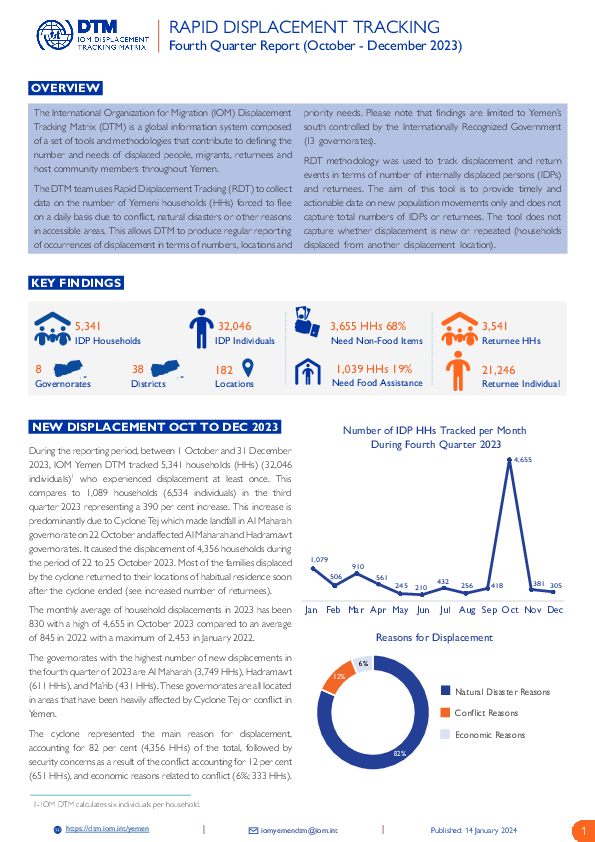-
Countries
-
Data and Analysis
-
Special Focus
-
Crisis Responses

Contact
DTM DRC, iomdrcdtm@iom.int
Language
French
Location
Democratic Republic of the Congo
Period Covered
Jan 01 2023
Dec 31 2023
Activity
- Other
La RDC est confrontée à l’une des plus importantes, complexes et longues crises humanitaires au monde. Marquée par des déplacements massifs, des besoins critiques en services sociaux et des violations des droits humains, cette crise est le résultat de conflits armés et interethniques persistants, d’épidémies et de catastrophes naturelles. La menace constante de violence et la détérioration de la situation sécuritaire exacerbent la situation humanitaire de manière de plus en plus critique, générant plusieurs millions de personnes déplacées internes. En particulier, dans les provinces de l'est, la résurgence des conflits armés et des violences intercommunautaires entrave l'accès et la délivrance de services humanitaires, alors que les besoins restent extrêmement élevés.
Pour répondre de manière opportune aux besoins humanitaires urgents et offrir une assistance ciblée et adaptée au contexte, les acteurs humanitaires ont besoin d'informations sur les récents mouvements de populations, leurs emplacements et le profil de la population, l'Organisation Internationale pour les Migrations (OIM) a mis en place la DTM, conçue pour capturer, traiter et diffuser régulièrement et systématiquement ces informations. Cela vise à permettre aux décideurs de mieux comprendre les tendances migratoires, les besoins évolutifs des populations déplacées et faciliter la prise de décision. Ce rapport résume les activités clés réalisées par DTM en RDC ainsi que les principales réussites de l'équipe pour l'année 2023.

Contact
DTM DRC, iomdrcdtm@iom.int
Language
English
Location
Democratic Republic of the Congo
Period Covered
Jan 01 2023
Dec 31 2023
Activity
- Other
The DRC is facing one of the largest, most complex and longest-running humanitarian crises in the world. Marked by massive displacement, critical needs for basic services and human rights violations, this crisis is the result of persistent armed and inter-ethnic conflicts, epidemics and natural disasters. The constant threat of violence and the deteriorating security situation are exacerbating the humanitarian situation in an increasingly critical way, generating several million internally displaced people. In the eastern provinces in particular, the resurgence of armed conflict and inter-communal violence is hampering access to and the delivery of humanitarian services, while needs remain extremely high.
In order to respond in a timely manner to urgent humanitarian needs and provide targeted assistance adapted to the context, humanitarian actors require information on recent population movements, their locations and the profile of the population. The International Organization for Migration (IOM) has set up the DTM, designed to capture, process and disseminate this information regularly and systematically. The aim is to give decisionmakers a better understanding of migration trends and the changing needs of displaced populations, and to facilitate decision-making. This report summarizes the key activities undertaken by DTM DRC alongside the team's principal achievements of 2023.

Contact
DTMUkraine@iom.int
Language
English
Location
Ukraine
Period Covered
Sep 01 2023
Oct 31 2023
Activity
- Return Intention
- Mobility Tracking
За даними УВКБ ООН, станом на вересень 2023 року в Україні залишаються внутрішньо переміщеними особами приблизно 3 674 000 осіб, а за кордоном – приблизно 6 203 600 осіб. За оцінками МОМ, 4 573 000 осіб повернулися до місця свого постійного проживання в Україні після періоду переміщення, 22% з яких повернулися з-за кордону.
Для інформування про цільові заходи, спрямовані на пом'якшення вразливості, яка виникає через погані структурні та соціальні умови в районах повернення, CoRA надає детальні дані про те, де відбувається повернення, де ті, хто повернувся, є найбільш вразливими та чому.

Contact
DTM Cameroon, DTMCameroun@iom.int
Language
French
Location
Cameroon
Period Covered
Jan 09 2024
Jan 15 2024
Activity
- Mobility Tracking
- Event Tracking
Le suivi des situations d’urgence (en anglais, Emergency Tracking Tool, ETT) est une des composantes de la Matrice de suivi des déplacements (en anglais, Displacement Tracking Matrix, DTM) déployée par l’Organisation Internationale pour les Migrations (OIM). Il a pour objectif de rassembler des informations sur les mouvements significatifs et soudains de populations, ainsi que sur des urgences sécuritaires et climatiques. Les données ont été collectées par observation directe et par des entretiens téléphoniques, auprès de six informateurs clés, principalement des autorités locales, des organisations non-gouvernementales (ONG), des organisations de la société civile (OSC) et des représentants des populations dans les lieux affectés.
Ce tableau de bord présente des informations sur le déplacement de populations des localités de Tourou, Loctcha, Batawaya, Ldamang, Ldubam (arrondissement de Mokolo) et Godzongodzong (arrondissement du Mayo-Moskota) vers les localités de Mikilik, Sirak-Gorai,Ouro-Tada (Sekande), Ldamang (kedalai), Ldubam, Djimeta, Zimangayak, Fada, Ldamtsaï, Mendejé et Zamalva, arrondissement de Mokolo, département du Mayo -Tsanaga.
Contact
DTMUkraine@iom.int
Location
Ukraine
Activity
- Mobility Tracking
- Baseline Assessment
Period Covered
Dec 01 2023 -Dec 31 2023
The data collected for the Area Baseline Assessment Round 31 reflects the up-to-date local administrative register of the IDP population as of 31 December 2023, equivalent to a total of 3,522,045 registered IDPs. Registered IDP figures were collected for 108 raions. Data disaggregated by age, sex and disability status were provided for around 78 per cent of the administrative units covered.
A more detailed version of this dataset at the Hromada level is available. To get access, kindly click on the 'Request Access' button.
Population Groups
IDPs
Survey Methodology
Unit of Analysis Or Observation
Admin Area 2
Type of Survey or Assessment
Key Informant
Keywords
Geographical Scope Partial Coverage
Administrative boundaries with available data
The current dataset covers the following administrative boundaries

Contact
DTMUkraine@iom.int
Language
English
Location
Ukraine
Period Covered
Dec 01 2023
Dec 31 2023
Activity
- Baseline Assessment
The Registered IDP Area Baseline Assessment provides granular data on the number and geographic location of officially registered internally displaced people (IDPs). This report assesses registered IDP presence at the raion level, also mapping the recorded change since the previous round. Round 31 presents the data of the registered IDP population disaggregated by sex, age and state-recognised disability status.
The data collected for the Area Baseline Assessment Round 31 reflects the up-to-date local administrative register of the IDP population as of 31 December 2023, equivalent to a total of 3,522,045 registered IDPs. Registered IDP figures were collected for 108 raions. Data disaggregated by age, sex and disability status were provided for around 78 per cent of the administrative units covered.

Contact
RO Dakar, RODakar-DataResearch@iom.int
Language
English
Location
Global
Period Covered
Jan 16 2019
Jun 01 2023
Activity
- Survey
- Flow Monitoring Survey
- Flow Monitoring
- Mobility Tracking
Cross-border transhumance is a long-standing traditional pastoral practice in West and Central Africa (WCA) whereby herders migrate seasonally, crossing borders with their livestock, in search of water and pasture. In a region characterized by long dry seasons, livestock mobility is an important form of adaptation, helping to build resilience to the climatic, economic and security risks and vulnerabilities faced by the region's herders.
This report aims to present, in a non-exhaustive way, the main results obtained by the implementation of the Transhumance Tracking Tool since its first implementation in 2019, up until June 2023.
Contact
DTM Yemen, iomyemendtm@iom.int
Location
Yemen
Activity
- Mobility Tracking
- Event Tracking
Period Covered
Oct 01 2023 -Dec 31 2023
From 1 January to 31 December 2023, IOM Yemen DTM tracked 9,958 households (HH) (59,748 Individuals) who experienced displacement at least once.
Between 1 October and 31 December 2023, IOM Yemen DTM tracked 5,341 households (32,046 individuals) displaced at least once. The majority of people moved into/within the following governorates and districts:
- Al Maharah (3,749 HHs) – Haswin (1815 HHs), Al Ghaydhah (1,123 HHs), Qishn (310 HHs) districts. Most displacements in the governorate originated from Marib and Al Hodeidah.
- Hadramawt (611 HHs) – Ar Raydah wa Qussayar (597 HHs), Ad Dis (10 HHs), Ash Shihr (4 HHs) districts. Most displacements in the governorate originated from Taiz and Al Hodeidah.
- Ma’rib (431 HHs) – Marib City (217 HHs), Marib (152 HHs), Harib (60 HHs) districts. All displacements in the governorate were internal.
The majority of people moved from the following governorates and districts:
- Al Maharah (3,750 HHs) – Al Ghaydhah (2,773 HHs), Qishn (310 HHs), Haswin (216 HHs) districts.
- Hadramawt (612 HHs) – Ar Raydah wa Qussayar (607 HHs), Sayun (2 HHs), Al Abr (1 HHs) districts.
- Al Hodeidah (347 HHs) – At Tuhayta (161 HHs), Hays (40 HHs), Al Jarrahi (31 HHs) districts.
Population Groups
Survey Methodology
Unit of Analysis Or Observation
Type of Survey or Assessment
Keywords
Geographical Scope
Administrative boundaries with available data
The current dataset covers the following administrative boundaries

Contact
DTMCostaRica@iom.int
Language
English
Location
Costa Rica
Period Covered
Dec 01 2023
Dec 31 2023
Activity
- Flow Monitoring
- Mobility Tracking
- Event Tracking
Cantons: Liberia, Los Chiles, San Carlos, Heredia, Alajuela, Cartago, San José y Corredores.
Costa Rica, like the other countries in the Central American region, has been characterized as a migratory corridor for people who transit by land from the south to the north of America and whose destination is the countries in the north of the continent. This flow on the move through the Americas is mainly made up of people from the Bolivarian Republic of Venezuela, Cuba, Haiti, Ecuador, as well as people from other countries in South America, Africa and Asia.
According to estimations from IOM Costa Rica, during December 28,721 people entered the country, an approximate average of 926 people per day and estimating a decrease of 32% compared to November 2023. In addition, 1,888 people stranded in the monitored shelters were identified and 1,345 people stranded in the public places visited.

Contact
DTM Yemen, iomyemendtm@iom.int
Language
English
Location
Yemen
Period Covered
Oct 01 2023
Dec 31 2023
Activity
- Mobility Tracking
- Event Tracking
During the reporting period, between 1 October and 31 December 2023, IOM Yemen DTM tracked 5,341 households (HHs) (32,046 individuals)1 who experienced displacement at least once. This compares to 1,089 households (6,534 individuals) in the third quarter 2023 representing a 390 per cent increase. This increase is predominantly due to Cyclone Tej which made landfall in Al Maharah governorate on 22 October and affected Al Maharah and Hadramawt governorates. It caused the displacement of 4,356 households during the period of 22 to 25 October 2023.
Most of the families displaced by the cyclone returned to their locations of habitual residence soon after the cyclone ended (see increased number of returnees).
The monthly average of household displacements in 2023 has been 830 with a high of 4,655 in October 2023 compared to an average of 845 in 2022 with a maximum of 2,453 in January 2022.
The governorates with the highest number of new displacements in the fourth quarter of 2023 are Al Maharah (3,749 HHs), Hadramawt (611 HHs), and Ma’rib (431 HHs). These governorates are all located in areas that have been heavily affected by Cyclone Tej or conflict in Yemen.
The cyclone represented the main reason for displacement, accounting for 82 per cent (4,356 HHs) of the total, followed by security concerns as a result of the conflict accounting for 12 per cent (651 HHs), and economic reasons related to conflict (6%; 333 HHs).
